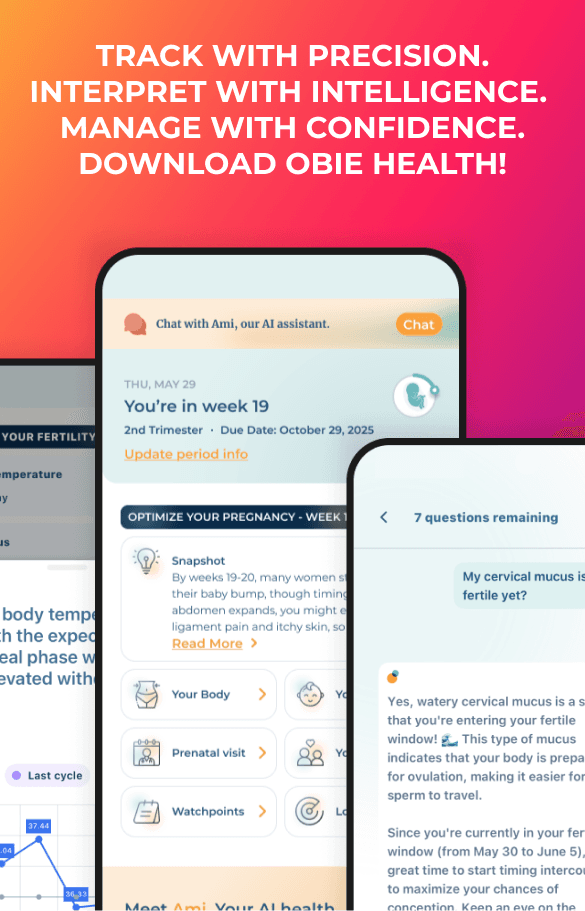Heart Rate Variability Across Menstrual Phases May Reveal Your Cardiac Resilience
Obie Editorial Team

When we think about menstrual cycles, we often focus on reproductive health. However, recent research suggests that the changes happening across your cycle can also provide a window into your heart health. In particular, a growing body of evidence links menstrual phases to heart rate variability (HRV)—a key marker of how well your body handles and recovers from stress. Understanding this connection may help women spot early signs of cardiovascular risk and take steps toward long-term wellness.
Why Heart Rate Variability Matters
Heart rate variability (HRV) measures the time differences between heartbeats. A higher HRV is generally associated with better cardiovascular fitness and a more resilient autonomic nervous system—the system that controls stress responses, heart rate, digestion, and more. Lower HRV, on the other hand, has been linked to increased risk of high blood pressure, heart disease, and even stroke.
What makes HRV particularly fascinating is that it’s not just a reflection of physical fitness. It also mirrors how well your nervous system can adapt to changes, whether from emotional stress, physical activity, or hormonal shifts.
The Menstrual Cycle-HRV Connection
Throughout the menstrual cycle, hormonal fluctuations, especially in estrogen and progesterone, affect how your autonomic nervous system functions. These changes can subtly shift your HRV in ways that offer insight into your cardiovascular resilience.
A 2020 study published in the Journal of Clinical Medicine found that HRV, specifically the vagally mediated component (which reflects parasympathetic or “rest and digest” activity), decreases during the luteal phase when progesterone is at its peak. The study showed that HRV is not static but shifts in a predictable pattern across the cycle in many women.
In simpler terms, your body’s ability to bounce back from stress may decrease in the second half of your cycle. Over time, these changes could be early indicators of how your cardiovascular system is aging or responding to stress.
What This Means for Your Health
If you experience irregular, painful, or absent periods, it could signal more than just a reproductive concern. Conditions like polycystic ovary syndrome (PCOS) and premature ovarian insufficiency (POI) are associated with disrupted hormone patterns, and they’re also linked to increased cardiovascular risk.
Women in their 30s and 40s—often balancing stress from work, caregiving, or other life changes—are in a prime window for early detection and prevention. Paying attention to your cycle patterns can provide valuable clues about your long-term heart health.
Practical Takeaways for Monitoring and Supporting HRV
While you can’t change your biology, you can become more in tune with it. Here are some practical, evidence-based ways to support your HRV and cardiovascular resilience across your cycle:
- Track your menstrual cycle using the reliable Obie app or a journal to identify patterns or irregularities.
- Wearable devices that measure HRV (like WHOOP or Oura Ring) should be considered to see how your autonomic function changes throughout your cycle.
- Prioritize sleep, especially during the luteal phase, when your body may be more sensitive to stress.
- Practice consistent, moderate exercise to improve baseline HRV—avoid overtraining, especially in the days before your period.
- Incorporate stress management techniques like deep breathing, meditation, or yoga, particularly during the second half of your cycle.
- Talk to your healthcare provider if your periods are consistently irregular, absent, or unusually painful—these may be signs of an underlying endocrine or cardiovascular issue.
A Biomarker, Not Just a Symptom
Menstrual cycle patterns and heart rate variability are both valuable metrics, individually and together, for understanding your broader health picture. HRV is emerging as a noninvasive, real-time indicator of how your heart and nervous system respond to hormonal changes. By recognizing these shifts early, women can intervene with lifestyle adjustments or clinical guidance before cardiovascular risk becomes disease.
Understanding the menstrual-cardiac connection isn’t just about managing periods—it’s about protecting the heart, literally and figuratively.
Source:
Schmalenberger KM, Eisenlohr-Moul TA, Jarczok MN, Eckstein M, Schneider E, Brenner IG, Duffy K, Schweizer S, Kiesner J, Thayer JF, Ditzen B. Menstrual Cycle Changes in Vagally-Mediated Heart Rate Variability are Associated with Progesterone: Evidence from Two Within-Person Studies. J Clin Med. 2020 Feb 25;9(3):617. doi: 10.3390/jcm9030617. PMID: 32106458; PMCID: PMC7141121.







